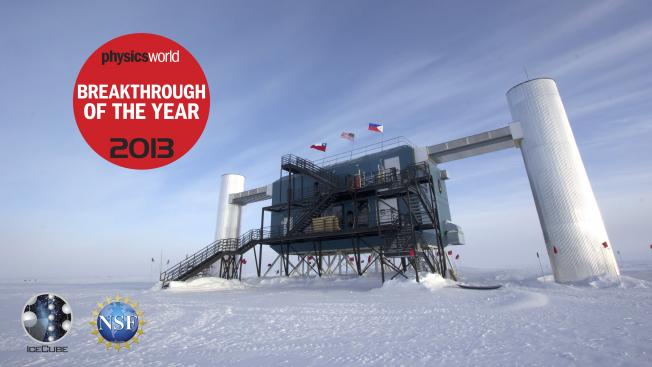A Search for Coincident Neutrino Emission from Fast Radio Bursts with Seven Years of IceCube Cascade Events
The Astrophysical Journal American Astronomical Society 946:2 (2023) 80
Authors:
R Abbasi, M Ackermann, J Adams, SK Agarwalla, JA Aguilar, M Ahlers, JM Alameddine, NM Amin, K Andeen, G Anton, C Argüelles, Y Ashida, S Athanasiadou, SN Axani, X Bai, A Balagopal V., M Baricevic, SW Barwick, V Basu, R Bay, JJ Beatty, K-H Becker, J Becker Tjus, J Beise, C Bellenghi, S BenZvi, D Berley, E Bernardini, DZ Besson, G Binder, D Bindig, E Blaufuss, S Blot, F Bontempo, JY Book, C Boscolo Meneguolo, S Böser, O Botner, J Böttcher, E Bourbeau, J Braun, B Brinson, J Brostean-Kaiser, RT Burley, RS Busse, D Butterfield, MA Campana, K Carloni, EG Carnie-Bronca, S Chattopadhyay, C Chen, Z Chen, D Chirkin, S Choi, BA Clark, L Classen, A Coleman, GH Collin, A Connolly, JM Conrad, P Coppin, P Correa, S Countryman, DF Cowen, P Dave, C De Clercq, JJ DeLaunay, D Delgado López, H Dembinski, K Deoskar, A Desai, P Desiati, KD de Vries, G de Wasseige, T DeYoung, A Diaz, JC Díaz-Vélez, M Dittmer, A Domi, H Dujmovic, MA DuVernois, T Ehrhardt, P Eller, R Engel, H Erpenbeck, J Evans, PA Evenson, KL Fan, K Fang, AR Fazely, A Fedynitch, N Feigl, S Fiedlschuster, C Finley, L Fischer, D Fox, A Franckowiak, E Friedman, A Fritz, P Fürst, TK Gaisser, J Gallagher, E Ganster, A Garcia, S Garrappa, L Gerhardt, A Ghadimi, C Glaser, T Glauch, T Glüsenkamp, N Goehlke, JG Gonzalez, S Goswami, D Grant, SJ Gray, S Griffin, S Griswold, C Günther, P Gutjahr, C Haack, A Hallgren, R Halliday, L Halve, F Halzen, H Hamdaoui, M Ha Minh, K Hanson, J Hardin, AA Harnisch, P Hatch, A Haungs, K Helbing, J Hellrung, F Henningsen, L Heuermann, S Hickford, A Hidvegi, C Hill, GC Hill, KD Hoffman, K Hoshina, W Hou, T Huber, K Hultqvist, M Hünnefeld, R Hussain, K Hymon, S In, N Iovine, A Ishihara, M Jacquart, M Jansson, GS Japaridze, K Jayakumar, M Jeong, M Jin, BJP Jones, D Kang, W Kang, X Kang, A Kappes, D Kappesser, L Kardum, T Karg, M Karl, A Karle, U Katz, M Kauer, JL Kelley, A Khatee Zathul, A Kheirandish, K Kin, J Kiryluk, SR Klein, A Kochocki, R Koirala, H Kolanoski, T Kontrimas, L Köpke, C Kopper, DJ Koskinen, P Koundal, M Kovacevich, M Kowalski, T Kozynets, K Kruiswijk, E Krupczak, A Kumar, E Kun, N Kurahashi, N Lad, C Lagunas Gualda, M Lamoureux, MJ Larson, F Lauber, JP Lazar, JW Lee, K Leonard DeHolton, A Leszczyńska, M Lincetto, QR Liu, M Liubarska, E Lohfink, C Love, CJ Lozano Mariscal, L Lu, F Lucarelli, A Ludwig, W Luszczak, Y Lyu, W Y., J Madsen, KBM Mahn, Y Makino, S Mancina, W Marie Sainte, IC Mariş, S Marka, Z Marka, M Marsee, I Martinez-Soler, R Maruyama, F Mayhew, T McElroy, F McNally, JV Mead, K Meagher, S Mechbal, A Medina, M Meier, S Meighen-Berger, Y Merckx, L Merten, J Micallef, D Mockler, T Montaruli, RW Moore, Y Morii, R Morse, M Moulai, T Mukherjee, R Naab, R Nagai, M Nakos, U Naumann, J Necker, M Neumann, H Niederhausen, MU Nisa, A Noell, SC Nowicki, A Obertacke Pollmann, V O’Dell, M Oehler, B Oeyen, A Olivas, R Orsoe, J Osborn, E O’Sullivan, H Pandya, N Park, GK Parker, EN Paudel, L Paul, C Pérez de los Heros, J Peterson, S Philippen, S Pieper, A Pizzuto, M Plum, Y Popovych, M Prado Rodriguez, B Pries, R Procter-Murphy, GT Przybylski, C Raab, J Rack-Helleis, K Rawlins, Z Rechav, A Rehman, P Reichherzer, G Renzi, E Resconi, S Reusch, W Rhode, M Richman, B Riedel, EJ Roberts, S Robertson, S Rodan, G Roellinghoff, M Rongen, C Rott, T Ruhe, L Ruohan, D Ryckbosch, S Athanasiadou, I Safa, J Saffer, D Salazar-Gallegos, P Sampathkumar, SE Sanchez Herrera, A Sandrock, M Santander, S Sarkar, S Sarkar, J Savelberg, P Savina, M Schaufel, H Schieler, S Schindler, B Schlüter, T Schmidt, J Schneider, FG Schröder, L Schumacher, G Schwefer, S Sclafani, D Seckel, S Seunarine, A Sharma, S Shefali, N Shimizu, M Silva, B Skrzypek, B Smithers, R Snihur, J Soedingrekso, A Søgaard, D Soldin, G Sommani, C Spannfellner, GM Spiczak, C Spiering, M Stamatikos, T Stanev, R Stein, T Stezelberger, T Stürwald, T Stuttard, GW Sullivan, I Taboada, S Ter-Antonyan, WG Thompson, J Thwaites, S Tilav, K Tollefson, C Tönnis, S Toscano, D Tosi, A Trettin, CF Tung, R Turcotte, JP Twagirayezu, B Ty, MA Unland Elorrieta, AK Upadhyay, K Upshaw, N Valtonen-Mattila, J Vandenbroucke, N van Eijndhoven, D Vannerom, J van Santen, J Vara, J Veitch-Michaelis, M Venugopal, S Verpoest, D Veske, C Walck, TB Watson, C Weaver, P Weigel, A Weindl, J Weldert, C Wendt, J Werthebach, M Weyrauch, N Whitehorn, CH Wiebusch, N Willey, DR Williams, M Wolf, G Wrede, J Wulff, XW Xu, JP Yanez, E Yildizci, S Yoshida, F Yu, S Yu, T Yuan, Z Zhang, P Zhelnin, IceCube CollaborationD-Egg: a dual PMT optical module for IceCube
Journal of Instrumentation IOP Publishing 18:04 (2023) p04014
Authors:
R Abbasi, M Ackermann, J Adams, N Aggarwal, JA Aguilar, M Ahlers, JM Alameddine, AA Alves, NM Amin, K Andeen, T Anderson, G Anton, C Argüelles, Y Ashida, S Athanasiadou, SN Axani, X Bai, A Balagopal V., M Baricevic, SW Barwick, V Basu, R Bay, JJ Beatty, K-H Becker, J Becker Tjus, J Beise, C Bellenghi, S BenZvi, D Berley, E Bernardini, DZ Besson, G Binder, D Bindig, E Blaufuss, S Blot, F Bontempo, JY Book, J Borowka, C Boscolo Meneguolo, S Böser, O Botner, J Böttcher, E Bourbeau, J Braun, B Brinson, J Brostean-Kaiser, RT Burley, RS Busse, MA Campana, EG Carnie-Bronca, C Chen, Z Chen, D Chirkin, S Choi, BA Clark, L Classen, A Coleman, GH Collin, A Connolly, JM Conrad, P Coppin, P Correa, S Countryman, DF Cowen, C Dappen, P Dave, C De Clercq, JJ DeLaunay, D Delgado López, H Dembinski, K Deoskar, A Desai, P Desiati, KD de Vries, G de Wasseige, T DeYoung, A Diaz, JC Díaz-Vélez, M Dittmer, H Dujmovic, MA DuVernois, T Ehrhardt, P Eller, R Engel, H Erpenbeck, J Evans, PA Evenson, KL Fan, AR Fazely, A Fedynitch, N Feigl, S Fiedlschuster, AT Fienberg, C Finley, L Fischer, D Fox, A Franckowiak, E Friedman, A Fritz, P Fürst, TK Gaisser, J Gallagher, E Ganster, A Garcia, S Garrappa, L Gerhardt, A Ghadimi, C Glaser, T Glauch, T Glüsenkamp, N Goehlke, JG Gonzalez, S Goswami, D Grant, SJ Gray, T Grégoire, S Griffin, S Griswold, C Günther, P Gutjahr, C Haack, A Hallgren, R Halliday, L Halve, F Halzen, H Hamdaoui, M Ha Minh, K Hanson, J Hardin, AA Harnisch, P Hatch, A Haungs, K Helbing, J Hellrung, F Henningsen, L Heuermann, S Hickford, A Hidvegi, C Hill, GC Hill, KD Hoffman, K Hoshina, W Hou, T Huber, K Hultqvist, M Hünnefeld, R Hussain, K Hymon, S In, N Iovine, A Ishihara, M Jansson, GS Japaridze, M Jeong, M Jin, BJP Jones, D Kang, W Kang, X Kang, A Kappes, D Kappesser, L Kardum, T Karg, M Karl, A Karle, U Katz, M Kauer, JL Kelley, A Kheirandish, K Kin, J Kiryluk, SR Klein, A Kochocki, R Koirala, H Kolanoski, T Kontrimas, L Köpke, C Kopper, DJ Koskinen, P Koundal, M Kovacevich, M Kowalski, T Kozynets, K Kruiswijk, E Krupczak, A Kumar, E Kun, N Kurahashi, N Lad, C Lagunas Gualda, M Lamoureux, MJ Larson, F Lauber, JP Lazar, JW Lee, K Leonard DeHolton, A Leszczyńska, M Lincetto, QR Liu, M Liubarska, E Lohfink, C Love, CJ Lozano Mariscal, L Lu, F Lucarelli, A Ludwig, W Luszczak, Y Lyu, WY Ma, J Madsen, KBM Mahn, Y Makino, S Mancina, W Marie Sainte, IC Mariş, S Marka, Z Marka, M Marsee, I Martinez-Soler, R Maruyama, F Mayhew, T McElroy, F McNally, JV Mead, K Meagher, S Mechbal, A Medina, M Meier, S Meighen-Berger, Y Merckx, L Merten, T Meures, J Micallef, D Mockler, T Montaruli, RW Moore, Y Morii, R Morse, M Moulai, T Mukherjee, R Naab, R Nagai, U Naumann, A Nayerhoda, J Necker, M Neumann, H Niederhausen, MU Nisa, A Noell, SC Nowicki, A Obertacke Pollmann, M Oehler, B Oeyen, A Olivas, R Orsoe, J Osborn, E O'Sullivan, H Pandya, DV Pankova, N Park, GK Parker, EN Paudel, L Paul, C Pérez de los Heros, J Peterson, S Philippen, S Pieper, A Pizzuto, M Plum, Y Popovych, M Prado Rodriguez, B Pries, R Procter-Murphy, GT Przybylski, C Raab, J Rack-Helleis, K Rawlins, Z Rechav, A Rehman, P Reichherzer, G Renzi, E Resconi, S Reusch, W Rhode, M Richman, B Riedel, EJ Roberts, S Robertson, S Rodan, G Roellinghoff, M Rongen, C Rott, T Ruhe, L Ruohan, D Ryckbosch, D Rysewyk Cantu, S Athanasiadou, I Safa, J Saffer, D Salazar-Gallegos, P Sampathkumar, SE Sanchez Herrera, A Sandrock, P Sandstrom, M Santander, S Sarkar, S Sarkar, J Savelberg, P Savina, M Schaufel, H Schieler, S Schindler, B Schlüter, T Schmidt, J Schneider, FG Schröder, L Schumacher, G Schwefer, S Sclafani, D Seckel, S Seunarine, A Sharma, S Shefali, N Shimizu, S Shimizu, M Silva, B Skrzypek, B Smithers, R Snihur, J Soedingrekso, A Søgaard, D Soldin, C Spannfellner, GM Spiczak, C Spiering, M Stamatikos, T Stanev, R Stein, T Stezelberger, T Stürwald, T Stuttard, KH Sulanke, GW Sullivan, I Taboada, S Ter-Antonyan, WG Thompson, J Thwaites, S Tilav, K Tollefson, C Tönnis, S Toscano, D Tosi, A Trettin, CF Tung, R Turcotte, JP Twagirayezu, B Ty, MA Unland Elorrieta, K Upshaw, N Valtonen-Mattila, J Vandenbroucke, N van Eijndhoven, D Vannerom, J van Santen, J Vara, J Veitch-Michaelis, S Verpoest, D Veske, C Walck, TB Watson, C Weaver, J Weber, P Weigel, A Weindl, J Weldert, C Wendt, J Werthebach, M Weyrauch, N Whitehorn, CH Wiebusch, N Willey, DR Williams, I Wisher, M Wolf, G Wrede, J Wulff, XW Xu, JP Yanez, E Yildizci, S Yoshida, S Yu, T Yuan, Z Zhang, P Zhelnin, The IceCube CollaborationA Search for IceCube sub-TeV Neutrinos Correlated with Gravitational-Wave Events Detected By LIGO/Virgo
ArXiv 2303.1597 (2023)
Authors:
R Abbasi, M Ackermann, J Adams, SK Agarwalla, JA Aguilar, M Ahlers, JM Alameddine, NM Amin, K Andeen, G Anton, C Argüelles, Y Ashida, S Athanasiadou, SN Axani, X Bai, A Balagopal V, M Baricevic, SW Barwick, V Basu, R Bay, JJ Beatty, K-H Becker, J Becker Tjus, J Beise, C Bellenghi, S BenZvi, D Berley, E Bernardini, DZ Besson, G Binder, D Bindig, E Blaufuss, S Blot, F Bontempo, JY Book, C Boscolo Meneguolo, S Böser, O Botner, J Böttcher, E Bourbeau, J Braun, B Brinson, J Brostean-Kaiser, RT Burley, RS Busse, D Butterfield, MA Campana, K Carloni, EG Carnie-Bronca, S Chattopadhyay, N Chau, C Chen, Z Chen, D Chirkin, S Choi, BA Clark, L Classen, A Coleman, GH Collin, A Connolly, JM Conrad, P Coppin, P Correa, S Countryman, DF Cowen, P Dave, C De Clercq, JJ DeLaunay, D Delgado López, H Dembinski, K Deoskar, A Desai, P Desiati, KD de Vries, G de Wasseige, T DeYoung, A Diaz, JC Díaz-Vélez, M Dittmer, A Domi, H Dujmovic, MA DuVernois, T Ehrhardt, P Eller, R Engel, H Erpenbeck, J Evans, PA Evenson, KL Fan, K Fang, AR Fazely, A Fedynitch, N Feigl, S Fiedlschuster, C Finley, L Fischer, D Fox, A Franckowiak, E Friedman, A Fritz, P Fürst, TK Gaisser, J Gallagher, E Ganster, A Garcia, L Gerhardt, A Ghadimi, C Glaser, T Glauch, T Glüsenkamp, N Goehlke, JG Gonzalez, S Goswami, D Grant, SJ Gray, S Griffin, S Griswold, C Günther, P Gutjahr, C Haack, A Hallgren, R Halliday, L Halve, F Halzen, H Hamdaoui, M Ha Minh, K Hanson, J Hardin, AA Harnisch, P Hatch, A Haungs, K Helbing, J Hellrung, F Henningsen, L Heuermann, N Heyer, S Hickford, A Hidvegi, C Hill, GC Hill, KD Hoffman, K Hoshina, W Hou, T Huber, K Hultqvist, M Hünnefeld, R Hussain, K Hymon, S In, A Ishihara, M Jacquart, M Jansson, GS Japaridze, K Jayakumar, M Jeong, M Jin, BJP Jones, D Kang, W Kang, X Kang, A Kappes, D Kappesser, L Kardum, T Karg, M Karl, A Karle, U Katz, M Kauer, JL Kelley, A Khatee Zathul, A Kheirandish, J Kiryluk, SR Klein, A Kochocki, R Koirala, H Kolanoski, T Kontrimas, L Köpke, C Kopper, DJ Koskinen, P Koundal, M Kovacevich, M Kowalski, T Kozynets, K Kruiswijk, E Krupczak, A Kumar, E Kun, N Kurahashi, N Lad, C Lagunas Gualda, M Lamoureux, MJ Larson, F Lauber, JP Lazar, JW Lee, K Leonard DeHolton, A Leszczyńska, M Lincetto, QR Liu, M Liubarska, E Lohfink, C Love, CJ Lozano Mariscal, L Lu, F Lucarelli, A Ludwig, W Luszczak, Y Lyu, J Madsen, KBM Mahn, Y Makino, S Mancina, W Marie Sainte, IC Mariş, S Marka, Z Marka, M Marsee, I Martinez-Soler, R Maruyama, F Mayhew, T McElroy, F McNally, JV Mead, K Meagher, S Mechbal, A Medina, M Meier, S Meighen-Berger, Y Merckx, L Merten, J Micallef, T Montaruli, RW Moore, Y Morii, R Morse, M Moulai, T Mukherjee, R Naab, R Nagai, M Nakos, U Naumann, J Necker, M Neumann, H Niederhausen, MU Nisa, A Noell, SC Nowicki, A Obertacke Pollmann, V O'Dell, M Oehler, B Oeyen, A Olivas, R Orsoe, J Osborn, E O'Sullivan, H Pandya, N Park, GK Parker, EN Paudel, L Paul, C Pérez de los Heros, J Peterson, S Philippen, S Pieper, A Pizzuto, M Plum, A Pontén, Y Popovych, M Prado Rodriguez, B Pries, R Procter-Murphy, GT Przybylski, J Rack-Helleis, K Rawlins, Z Rechav, A Rehman, P Reichherzer, G Renzi, E Resconi, S Reusch, W Rhode, M Richman, B Riedel, EJ Roberts, S Robertson, S Rodan, G Roellinghoff, M Rongen, C Rott, T Ruhe, L Ruohan, D Ryckbosch, S Athanasiadou, I Safa, J Saffer, D Salazar-Gallegos, P Sampathkumar, SE Sanchez Herrera, A Sandrock, M Santander, S Sarkar, S Sarkar, J Savelberg, P Savina, M Schaufel, H Schieler, S Schindler, B Schlüter, F Schlüter, T Schmidt, J Schneider, FG Schröder, L Schumacher, G Schwefer, S Sclafani, D Seckel, S Seunarine, A Sharma, S Shefali, N Shimizu, M Silva, B Skrzypek, B Smithers, R Snihur, J Soedingrekso, A Søgaard, D Soldin, G Sommani, C Spannfellner, GM Spiczak, C Spiering, M Stamatikos, T Stanev, T Stezelberger, T Stürwald, T Stuttard, GW Sullivan, I Taboada, S Ter-Antonyan, WG Thompson, J Thwaites, S Tilav, K Tollefson, C Tönnis, S Toscano, D Tosi, A Trettin, CF Tung, R Turcotte, JP Twagirayezu, B Ty, MA Unland Elorrieta, AK Upadhyay, K Upshaw, N Valtonen-Mattila, J Vandenbroucke, N van Eijndhoven, D Vannerom, J van Santen, J Vara, J Veitch-Michaelis, M Venugopal, S Verpoest, D Veske, C Walck, TB Watson, C Weaver, P Weigel, A Weindl, J Weldert, C Wendt, J Werthebach, M Weyrauch, N Whitehorn, CH Wiebusch, N Willey, DR Williams, M Wolf, G Wrede, XW Xu, JP Yanez, E Yildizci, S Yoshida, F Yu, S Yu, T Yuan, Z Zhang, P ZhelninLimits on Neutrino Emission from GRB 221009A from MeV to PeV Using the IceCube Neutrino Observatory
The Astrophysical Journal Letters American Astronomical Society 946:1 (2023) L26
Authors:
R Abbasi, M Ackermann, J Adams, SK Agarwalla, N Aggarwal, JA Aguilar, M Ahlers, JM Alameddine, NM Amin, K Andeen, G Anton, C Argüelles, Y Ashida, S Athanasiadou, SN Axani, X Bai, A Balagopal V., M Baricevic, SW Barwick, V Basu, R Bay, JJ Beatty, K-H Becker, J Becker TjusAbstract:
Gamma-ray bursts (GRBs) have long been considered a possible source of high-energy neutrinos. While no correlations have yet been detected between high-energy neutrinos and GRBs, the recent observation of GRB 221009A—the brightest GRB observed by Fermi-GBM to date and the first one to be observed above an energy of 10 TeV—provides a unique opportunity to test for hadronic emission. In this paper, we leverage the wide energy range of the IceCube Neutrino Observatory to search for neutrinos from GRB 221009A. We find no significant deviation from background expectation across event samples ranging from MeV to PeV energies, placing stringent upper limits on the neutrino emission from this source.Sensitivity of the Cherenkov Telescope Array to spectral signatures of hadronic PeVatrons with application to Galactic Supernova Remnants
(2023)



